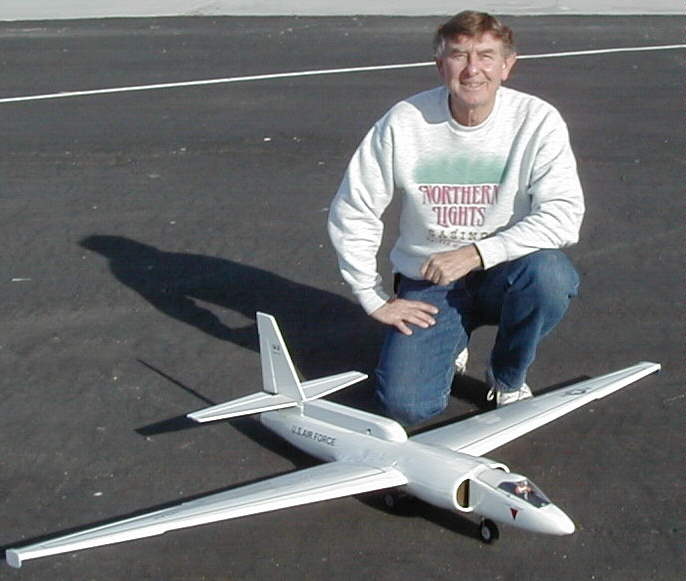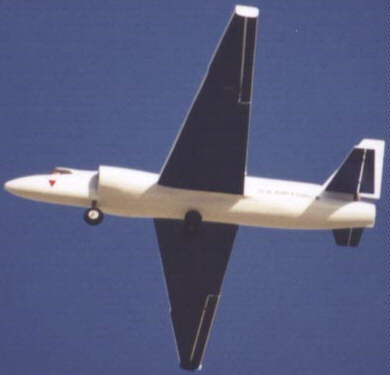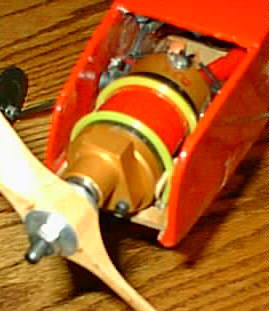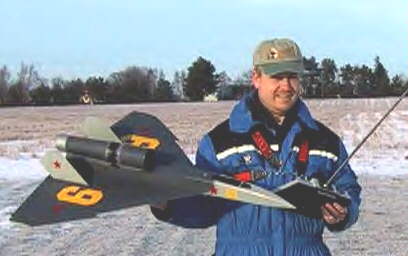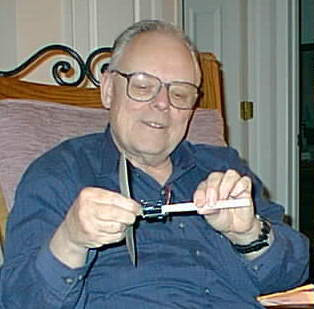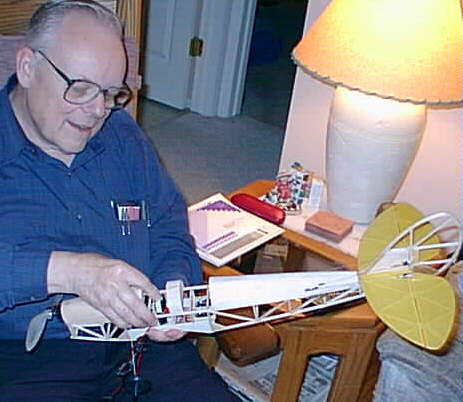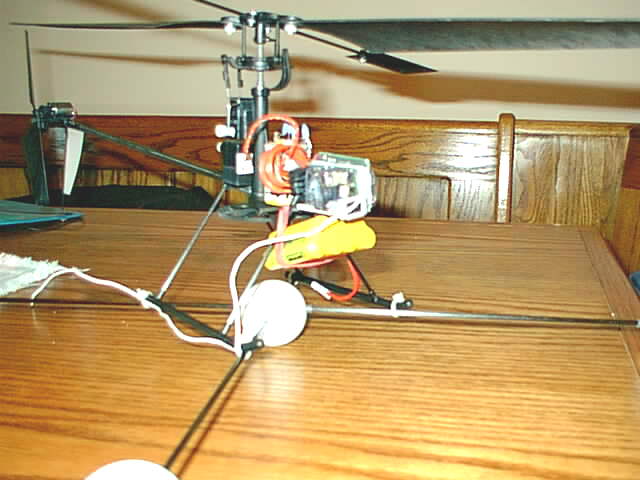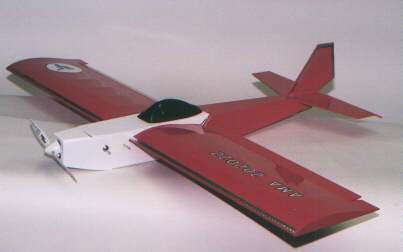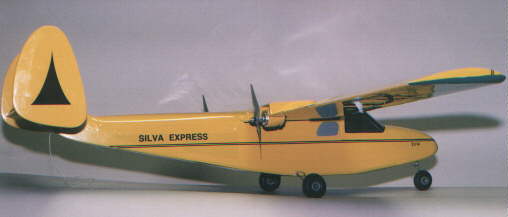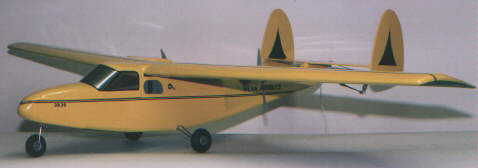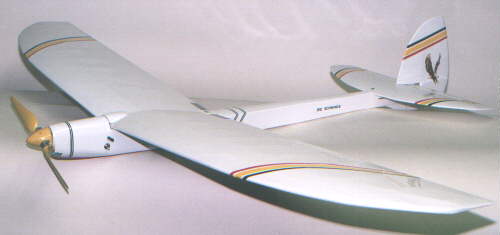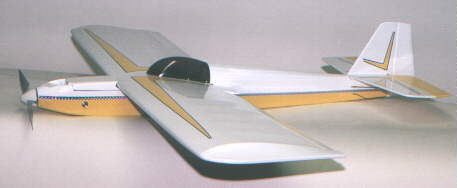 |
Flying High With Electric Power!
The Ampeer ON-LINE!
Fly the Future - Fly Electric! |
Site Table of Contents
| President: | Vice-President: | Secretary/Treasurer: |
| Ken Myers | Richard Utkan | |
| 1911 Bradshaw Ct. | 240 Cabinet | |
| Walled Lake, MI 48390 | Milford, MI 48381 | |
| (248) 669-8124 | (248) 685-1705 | |
 | ||
| Board of Directors: | Board of Directors: | Ampeer Editor |
| Jim McNeely | Jeff Hauser | Ken Myers |
| 4733 Crows Nest Ct. | 18200 Rosetta | 1911 Bradshaw Ct. |
| Brighton, MI 48116 | Eastpointe, MI 48021 | Walled Lake, MI 48390 |
| (810) 220-2297 | (810) 772-2499 | (248) 669-8124 |
| Mailed Ampeer subscriptions are $10 a year US & Canada and $17 a year world wide. FREE on-line! | ||
| The Next Meeting: Date: Thursday, March 1 Place: Ken Myers's house (address above) Time: 7:30 P.M. (see details in this issue) | ||
|
Fitz Walker has a new site for EP Helicopters. He has information on the current kits as well as conversions of glow powered helicopters. The URL is http://www.e-helis.com Looking for Help With Aeronaut A-10
I am and Englishman living and working in Holland and a very keen scale flyer. I'm
just making the leap of faith into electric scale. I bought (from Hobby-Land in Germany, who recommended all the 'extra's) an
Aeronaut A10 (51" span) with GRP fuselage, three mini servo's (metal geared...nice!) and 2 x Wemotec fan units with
some mean looking motors for the "in nacelle" conversion (supplied) .
NEAT Fair 2001 Open for Pre-Registration
I am excited to announce that the 2001 NEAT Fair website is ready to take
pre-registration. Those interested, please visit www.nyblimp.com/NEAT.htm
Vacuum Forming Info
I saw your website with vacuum forming info, thanks for mentioning my book. Check out my website at www.proto-form.com for the vacuum forming plans I offer. The Hobby-Vac machine is quite popular and it has 5 times more forming power than a vacuum cleaner can provide. My new website www.Build-Stuff.com will be operational in a few weeks and will have more books and videos and plans. Skyvolt Revisited There was a photo of a "fleet" of Skyvolts in the February 2001
Ampeer. I received some questions about whether it is still available. The Model Aviation plan is No. 639 and sells for
$15.00US plus $3.20US for shipping. To order the plan phone: 765.287.1256 ext. #505 or write to: AMA, 5151 E. Memorial Dr.,
Muncie, IN 47302. Customers outside the US, please call for shipping cost.
Bob Benjamin Online Bob is now online with a beautifully designed site at
www.rcmodel.com
SlowFlier/ParkFlier Problem?
Ken,
Upcoming Bluegrass Electric Fly-In
On behalf of the Lexington Miniature Aircraft Club, I would like to
announce the second annual Bluegrass Electric Fly-In on July 21, 2001 in Lexington, KY. This event will be held at our club field
which features a 600'x50' paved runway alongside a 600'x100' grass runway. This will be an all electric get together with the
emphasis on open flying and fun. We will have a Web page flyer with directions, event information, and hotel contacts in the
near future. It will be posted on Ezone in the events section and on our web page
located at http://fly.to/lmac. We would like to thank everyone that attended last year and made it
a great success. We all had a terrific time and look forward to seeing a great turn-out this year.
New E-Mail Address for Flash E-74 EDF
Hi Ken! I sent you the Flash E-74 EDF info a short while ago. (see
Feb. 2001 Ampeer KM) Well, last
night our DSL service "migrated" to our new DSL service without warning. I wanted to correct the e-mail address I
sent previously to: nankivil@telocity.com
The U-2: She Flies!
On Monday, January 22, 2001, I took my new U-2 to the Edwards AFB field for
her maiden flight. As customary for my maiden flights, Tony Frakowiak of NASA Dryden Research Center at Edwards, and
one of the very best RC pilots you will ever meet, was at the controls. Takeoff roll was straight and true, and those long wings
lifted the plane off at the 6 second mark, and she climbed straight into the western sky! First flight was 4 1/2 min with landing as
pretty as takeoff. One year to build. The U-2 is possibly the most beautiful plane in the air!
Wing Span: 74" Weight: 66.6 oz all up Power: single WeMoTec 480 fan with Plettenberg 200-20-6 motor Motor battery: 11x1000 mAh Nicads (plan to switch to NiMH later) Static: V=12.4, A=22.4, W=272 (all from WhattMeter) Addendum: Before this flight I had conversations with the Plettenberg factory regarding whether 11 cells was too much for the 200-20-6 motor. I have used this motor many times on various jets with 10 cells with no problems and excellent results. They suggested not to use more than 10 cells - I was on my own if I did. But, I felt that I needed the power, so away I went. I should have listened to Plettenberg! After just two successful flights the motor was thrashed. Sounds like a cement mixer. Haven't taken it out yet (it's major abdominal surgery to get to it), but likely the brushes are shot and probably the bearings also. Iíve got an 8' B-2 on the boards (just starting) that will have 4 WeMoTec/Plettenberg fans (the U-2 has just one). Scratch built as well. It could be awesome! Grant Calkins Muroc Model Masters - Edwards AFB, California Channel Islands Condors, Camarillo, CA Electric Conversion of the Sig Senorita
Ken sent an email inquiring about the Senorita. Unfortunately, his address bounced it back to me as undeliverable, so here is my reply, in hope that he may see it here. I'm looking for a construction article to convert the Sig Senorita to electric. I'm putting an Astro cobalt 25 geared in it. I seem to remember a few years ago one of the magazines ran an article on this subject. I specifically want to know how to mount the batteries and the motor and what else would need to be beefed up to handle the extra weight. I don't remember the article, but lots of folks have done it. Please check
members.aol.com/KMyersEFO/page384.htm and you can
hook up with 3 people who've rated it 4 and 5 stars, and they should be able to tell you how they mounted the motor and
batteries.
Kyosho Flash EP or Ken Eats Crow!
Hello again Mr. Myers! I wrote you early in December of last year and asked about the Kyosho Flash EP.
You told me not to spend any money on the plane, and I didn't. But my wife gave it to me for Christmas. Probably she had found
out that I was looking around for a new plane and had mentioned the Flash. Well, when you get a present from your wife you
canít change it, so I built it. And I must say that I'm very pleased with the model, and that's why I write you back. It's a very
good plane with plenty of thrust for aerobatic flight. I've tried to make a web page out of it with some video picks and some
pictures of the best electric plane that I've tried. Everything is built stock except for the mounting of aileron servo, and I have
changed the battery compartment to give room for 8 cells 1700 mAh or my new 2400 mAh battery. I've used HS-81 servos and
fly it with the landing gear on. It takes off from short grass in about 10-15 meters.
I am very happy that the Flash has worked out so well for you. Congratulations! KM Sanyo NiCad and NiMH Supplier
Hillís R/C can supply Sanyo cells at very reasonable prices. Steve sells matched or unmatched cells, as well as loose or assembled packs. He tests batteries for a major Sanyo distributor in exchange for special pricing on Sanyo products. For more information visit: http://sjslhill.hypermart.net Carlo Ciarniello's W1 Tailless Model
Hi Ken, Greetings from New Zealand. I made the W1 and powered it with a Graupner Speed 400 geared 2.33 motor; 7x600 battery; 9x5 folding prop and Kontronik Easy 3000 motor controller. I used an Eppler 205 airfoil and it is a great flyer, very docile and it thermals seemingly every time I fly it. It needs a little more reflex with this airfoil, about 5/16 inch at the root. I just thought you would like to know particularly after his tragic death. Thanks Doug. It is wonderful that we can keep creating great designs, even after the originator has passed on. Thanks for sharing with us. Carlo was a very active contributor to the Ampeer. I still think of him often. KM Upcoming Ft. Wayne Electric Fly, June 23
Dear Ken, This is my first time at putting on an Electric event, and I have tried hard to come up
with a format that would attract some folks. The flying field is located at the Ft. Wayne State School (Stellhorn and St. Joe ) and
has been LOFT's club flying site for over 25 years, it is large and mowed.
S-Models - New Name, Old Friend
Ken, I now have the name "S-Models" for my plane kits and designs. The
link is: http://www.komtek.no/fly/S_Models_mainpage.htm?
The February EFO Meeting Jack Lemon showed off his new indoor Tiger Moth. He is building it using the outlines only from the Sterling kit. The structure is unique and all his own. He has created a thrust adjustment "stick" that allows for vertical and horizontal adjustment of the motor thrust angle. It can be seen in the picture. When it is finished, it should weigh 11 ounces ready to fly. It is covered with tissue. The tissue was lightly coated with Balsa Rite and ironed on with a Monokote trim iron. It is designed with both indoor and outdoor flying in mind. Don Skiff shared the plans that he is drawing up for Bill Higgenís unique twin for S400 power. It has a 52" span with an elliptical wing plan form. It flies nicely and is thoughtfully designed. This may become a plan available in one of the magazines, so weíll keep you posted. Rick Sawicki showed his Elipstik 460 ARF from Northeast Sailplane, 948 Hercules Dr., Suite 12, Colchester, VT 05446 - phone: 1-802-655-7700 - Web site: www.nesail.com. Rick added a pod to the bottom to carry various size battery packs and the R/C gear. It uses a S400 for power. It weighed 13.6 ounces with the original S280 power and now weighs 16.5 ounces with the S400 power. Pete Foss showed off his Piccolo helicopter, which he purchased directly from
Germany. It has the Icarus receiver with a 72 MHz JR single channel crystal. It took him a day plus a couple of hours to put it
together, and heís been having a lot of fun flying it.
The Upcoming March Meeting The March 1 meeting will be at Kenís house at 7:30. Please bring those winter projects to share. Ken will also demonstrate what to do with the motor constants, once you have gathered them. Edís Airforce
Photo 1 is called the Squert and was designed by Derek Woodward. It was featured in the 12/97 issue of RCM. Wing span: 36.25" Fuselage length: 25.25", Wing area: 270 sq.in., Motor SP400, Aeronaut 6x3 folder, Hitec 535 Rx, 2 Hitec 101 servos, New Creations M-20 ESC, Weight with 7-cell 600 is 22 oz. Nice flier, 5-7 minutes of flight. Photo 2 and 3 is the Difina I.a Querandi designed by Dennis Topsfield, also in RCM. This is my first twin. Wing span: 56.5", Fuselage length: 37.5", 402 Sq.in., 2 7.2v Speed 400ís, APC 5.5x4.5 props, Futaba FP-R127DF Rx, 600 mAh Rx battery, 4 Hitec 101 servos, Pegasus 35 ESC, Weight: 52 oz., 7-cell 1700 mAh power pack. It has not flown yet because of the weather. Photo 4 is the Tiger Kitten designed by Bob Benjamin and built from the Ace kit. Wing span: 54", Fuselage length: 38", Wing area: 450 sq.in., Astro Flight 15 geared, 12 1700ís, Master Airscrew 11x7 electric prop, RCD 3200 Rx w/600 mAh Rx battery, 3 Hitec 101 servos, Viper Speed Demon ESC, Weight: 76 oz. Photo 5 is the Die Schwinge (Birdwing) designed by Hal Debolt. It appeared in the 4/94 issue of Model Airplane News. Wing span: 60", Fuselage length: 45", Wing area: 550 sq.in., Astro Flight 05 geared, 7 1700ís, 11x7 SonicTronic prop, Futaba R-114H Rx, 2 Hitec HS-80ís, FMA 30 ESC, Weight: 48.5 oz. I donít care for the speed control. It has too little variation, almost like an off/on switch. Photo 6 is the Crackle designed by Steven Pauly. It appeared in the 1/98 issue of Model Airplane News. Wing span: 46", Fuselage length: 36.25", Wing area: 445 sq.in., Astro Flight 05, 8 1700ís, Graupner 8x4.5 folder, Hitec 535 Rx w/270 mAh Rx pack, Jomar MiniMax ESC, Weight: 50 oz. Great flier. It can do everything in the hands of a good pilot (not me ;-) ) Photo 7 is the Mega Pepper designed by Dave Roblen and featured in the 7/00 issue
of Model Airplane News. Wing span: 44", Fuselage length: 30", Wing area: 352 sq.in., Speed 400, Olymus gearbox,
APC 9x4.5 electric prop, Hitec 555 Rx, 2 HS-81 servos, Astro Flight 215D ESC, 7 600 mAh battery, Weight: 22 oz. I love this
plane. It is easy to get 10 minute flights using the full range of speed.
Recommendations for Electric Powered Flight Systems (Part 2)
Here are the formulas written out using the various Flight Factors.
trainers and light planes (moderate performance types)
powered thermal sailplanes and old-timers (low performance types)
biplanes
The target weight is used to estimate the airframe weight, airborne radio system weight and power system requirements for a new project. The maximum weight is used as a control to verify a good chance for a successful plane. If the maximum weight is exceeded, the plane may still "fly." With the maximum weight exceeded, there is a good chance that many people would not call the plane successful or rewarding. Also, if the maximum weight is exceeded, the aircraft may become too difficult for the "average" modeler/pilot to fly because of an excessive wing loading for its size. Minimum Prop Diameter and Relative Pitch low-wing, mid-wing or high-wing (performance types)
trainers and light planes (moderate performance types)
powered thermal sailplanes and old-timers (low performance types)
biplanes
Component Weights power system weight can equal up to about 55% of the total weight
Prop Watts Out Watts out = (Diameter in inches/12)4 * (Pitch in inches/12)*KRPM3*Prop Multiplier Diameter and pitch are in inches. Prop Multipliers: 1.31 typical wood
prop, 1.18 folding carbon-fiber props, 1.11 standard APC props. KRPM is RPM in thousands.
Some Examples Using the Above Formulas 670 sq.in. low-wing, mid-wing or high-wing (performance types)
The power system needs to turn a 12x9 "typical" wood prop at about
7,000 RPM or better to be acceptable for this use.
670 sq.in. trainers and light planes (moderate performance types)
The power system needs to turn an 11x7 "typical" wood prop at about
7,500 RPM or better to be acceptable for this use.
670 sq.in. powered thermal sailplanes and old-timers (low performance types)
The power system needs to turn an 11x7 folder at about 5,900 RPM or better to be
acceptable for this use.
670 sq.in. biplane
The power system needs to turn an 11x6 "typical" wood prop at about
7,500 RPM or better to be acceptable for this use.
How about a multi? 670 sq.in. low-wing, mid-wing or high-wing (performance types) twin
Since it is a twin the weight needs to be cut in half for the following.
The power system needs two motors with 8x6 "typical" wood props at
about 11,000 RPM or better to be acceptable for this use.
Remember that the example above is for a performance twin, the same principle applies to the other types of multi-motor projects by using the performance type information and appropriate divisor. To Reach Ken Myers, you can land mail to the address at the top of the page. My E-mail
address is:
KMyersEFO@aol.com
|
